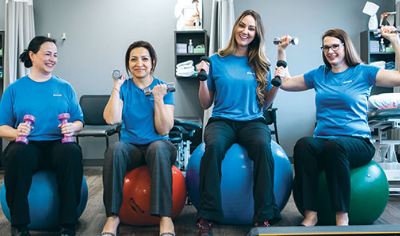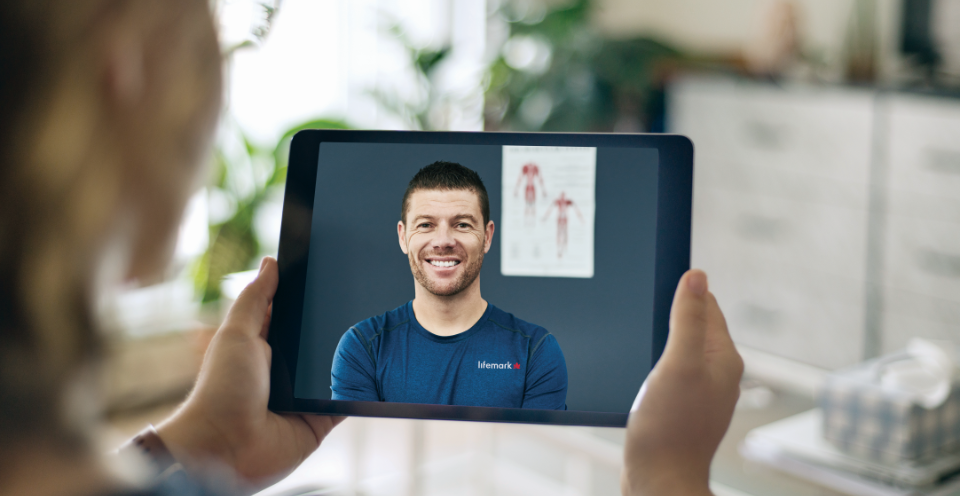Address:
Phone: 403-252-8535
Fax: 403-252-9021
Languages spoken
- English
- French
- Portuguese
- Spanish
- Tagalog (Filipino)
- Gujarati
- Hindi
- Punjabi
We are offering a variety of virtual care services. Call our clinic to learn more or to book an appointment.
Hours of operation
- Mon:7:00am-8:00pm
- Tue:7:00am-8:00pm
- Wed:7:00am-8:00pm
- Thu:7:00am-8:00pm
- Fri:7:00am-8:00pm
- Sat:Closed
- Sun:Closed
Lifemark Physiotherapy Southland Leisure Centre is a large multidisciplinary facility located on Southland Drive, on the second floor inside the Southland Leisure Centre in Calgary. We have a large parking lot with free parking.
Please phone us with any questions or to schedule an appointment.
Clinic information
Clinic information
Acupuncture (Traditional Chinese Medicine)
Clinical Pilates
Cupping Therapy
Intramuscular stimulation (IMS)
Temporomandibular Joint Rehabilitation
Visceral Massage
Visual Rehabilitation
Comprehensive Cognitive Assessment (CBS)
Functional Dry Needling
Work Conditioning/Hardening
Athletic therapy
Craniosacral Therapy
Delayed Development Rehabilitation and Management
Neurological Rehab
Shockwave Therapy

Join our team
Apply nowOur team
Our team
-
PhysiotherapistType Physiotherapist Book onlineLanguages: English
-
Physiotherapy ResidentType Physiotherapist Resident Book onlineLanguages: English, Portuguese
-
PhysiotherapistType Physiotherapist Book onlineLanguages: English
-
PhysiotherapistType Physiotherapist Book onlineLanguages: English
-
PhysiotherapistType Physiotherapist Book onlineLanguages: English, Punjabi, Hindi
-
AcupuncturistType Acupuncturist Book onlineLanguages: English, Spanish, Dutch
-
KinesiologistType KinesiologistLanguages: English
-
PhysiotherapistType Physiotherapist Book onlineLanguages: English
-
Registered Massage TherapistType Massage Therapist Book onlineLanguages: English
-
Physiotherapy ResidentType Physiotherapist Resident Book onlineLanguages: English, Hindi, Gujarati
-
PhysiotherapistType PhysiotherapistLanguages: English
-
PhysiotherapistType Physiotherapist Book onlineLanguages: English
-
PhysiotherapistType Physiotherapist Book onlineLanguages: English, Persian
-
Occupational TherapistType Occupational Therapist Book onlineLanguages: English
-
Registered Massage TherapistType Massage TherapistLanguages: English
-
Vestibular TherapistType Vestibular Book onlineLanguages: English
-
Massage TherapistType Massage TherapistLanguages: English, Spanish
Common conditions we treat
Common conditions we treat
-
Arthritis
Arthritis is the classifcation of approximately 200 rheumatic diseases and conditions that affect joints, the tissues that surround the joint, and other connective tissue, causing pain, stiffness and mobility challenges. Assessment and treatment from a physiotherapist and chiropractor may help relieve the pain and stiffness.
-
Carpal tunnel syndrome
Carpal tunnel syndrome is caused by pressure on the median nerve in the wrist and can result in numbness, tingling and pain in the affected hand and arm. It is often the result of repetitive use and strain. Physiotherapy can help alleviate some of the symptoms associated with carpal tunnel syndrome.
-
Concussion
A concussion is a brain injury that has physical symptoms such as headache, nausea, sensitivity to light and sound, and cognitive and emotional affects, including brain fog, lack of mental focus and fatigue. Concussion care services can help both speed recovery and prevent future injury. -
Dizziness and balance
Dizziness and balance issues can include vertigo, benign paroxysmal positional vertigo (BPPV), nausea, light-headedness, vision issues, motion sensitivity and sensitivity to crowds. They can severely impact quality of life if left untreated. Vestibular rehabilitation can help improve symptoms. -
Frozen shoulder
Frozen shoulder is a progressive condition that often starts with pain in the shoulder joint during basic movement. If the condition is left untreated, pain increases and mobility decreases. Physiotherapists can assess and develop a treatment plan.
-
Headaches
Headaches can be caused by a variety of conditions and once assessed by a healthcare professional can be helped with physiotherapy treatment.
-
Knee pain
Knee pain can be caused by bursitis, a torn tendon, ACL tear or injury and overuse. It is most frequently the result of osteoarthritis. Physiotherapy can help speed recovery.
-
Low back pain
Low back pain is one of the most common patient complaints. It can result from arthritis, spinal stenosis, scoliosis, sciatica, injury or overuse. An assessment from a physiotherapist or chiropractor can help provide a diagnosis and treatment plan.
-
Muscle sprains and strain
Muscles sprains and strains can result from sport or motor vehicle injuries, overuse or common activity. They can range to mild, moderate to severe requiring more intensive intervention. Physiotherapy and massage therapy can help speed recovery.
-
Neck pain
Neck pain can result from poor posture, injury like whiplash, infection in the lymph nodes or throat, or a herniated disc. Physiotherapy, massage therapy or chiropractic treatment can help improve mobility and pain.
-
Plantar fasciitis
Plantar fasciitis is one of the most common causes of heel pain. Plantar fasciitis commonly causes stabbing pain, usually occurring with the first steps in the morning. With activity, pain typically subsides, but can return after running or standing up after sitting for a length of time. It most commonly affects people who stand for long periods on hard surfaces, runners, and other high-impact athletes. Treatment from one of our foot care specialists may help to reduce the symptoms and pain.
-
Post-surgery
Complications following surgery can include pain, limited mobility, numbness and emotional issues. An assessment from a qualified physiotherapy along with a detailed treatment plan can help to alleviate post-surgery challenges.
-
Rotator cuff injuries
The rotator cuff consists of four muscles that surround the shoulder blade (scapula), and help to hold the arm bone (humerus) in the shoulder capsule. It is easily injured by sport, repetitive use and common daily activity. Physiotherapists can help diagnose and treat symptoms.
-
TMJ
Temporomandibular joint dysfunction or TMJ refers to pain and dysfunction of jaw muscles and the joints that connect the jaw bone to the skull. It is characterized by pain, difficulty chewing and noises (popping/cracking) when the jaw moves. Physiotherapy or massage therapy may help alleviate some of the symptoms of pain and discomfort.
-
Vestibular conditions
Coverage options
Virtual care
Virtual Care
 Virtual Care leverages video conference technology to provide services, including online physiotherapy, at a distance. Our video conference platform, built for healthcare professionals, allows you to consult a Lifemark clinician in the comfort of your own home.
Virtual Care leverages video conference technology to provide services, including online physiotherapy, at a distance. Our video conference platform, built for healthcare professionals, allows you to consult a Lifemark clinician in the comfort of your own home.
A clinician can assess or treat you, evaluate your range of motion, recommend exercises, give you advice on pain and pain management and much more.
Services from our specialty programs, such as pelvic health or concussion care, are also available through Virtual Care.
Secure, convenient online services
Virtual Care uses video conference technology to provide services at a distance that are private, secure and easy to use while giving you more flexibility by reducing travel time.
By removing accessibility and mobility barriers, Virtual Care ensures you can receive the care you need. Your privacy is protected through robust policies and safeguards and our clinicians are required to meet the same regulatory and legislative requirements and adhere to their respective Standards of Practice and Code of Conduct as they do for in-person services.
How it works
Before your appointment, you will receive a link to an online appointment session by email or text message. This link will take you to a video conference platform that will allow you to connect with your clinician and discuss your condition with them in real time.
You may be required to review and complete documentation before your appointment, which will be sent to you ahead of time.
For more information about our Virtual Care service, click the button below.
























